This post contains affiliate links.
It’s by no means typical to find a free space to park a tiny house, but Kaci and Eric’s experience shows that living small really can save you big! They found a kind 83-year-old man with a couple of acres, yurts, and a greenhouse who allows them to live on his land in Bend, Oregon, free of charge and even use his greenhouse and grounds to grow food. How amazing is that?
The couple (@kacisage on Instagram) live in their renovated school bus with their two adorable dogs, but they’ve been living tiny now for years in everything from a 200-square-foot cabin to a tent! We got the awesome opportunity to interview Kaci, so check out the Q&A after the photo tour.
Don’t miss other interesting tiny homes – join our FREE Tiny House Newsletter for more!
Bend, Oregon Bus Life Where they Park Free

Images via @kacisage/Instagram
How precious are these pups?

Images via @kacisage/Instagram
Plenty of closet space and the shower on the right.
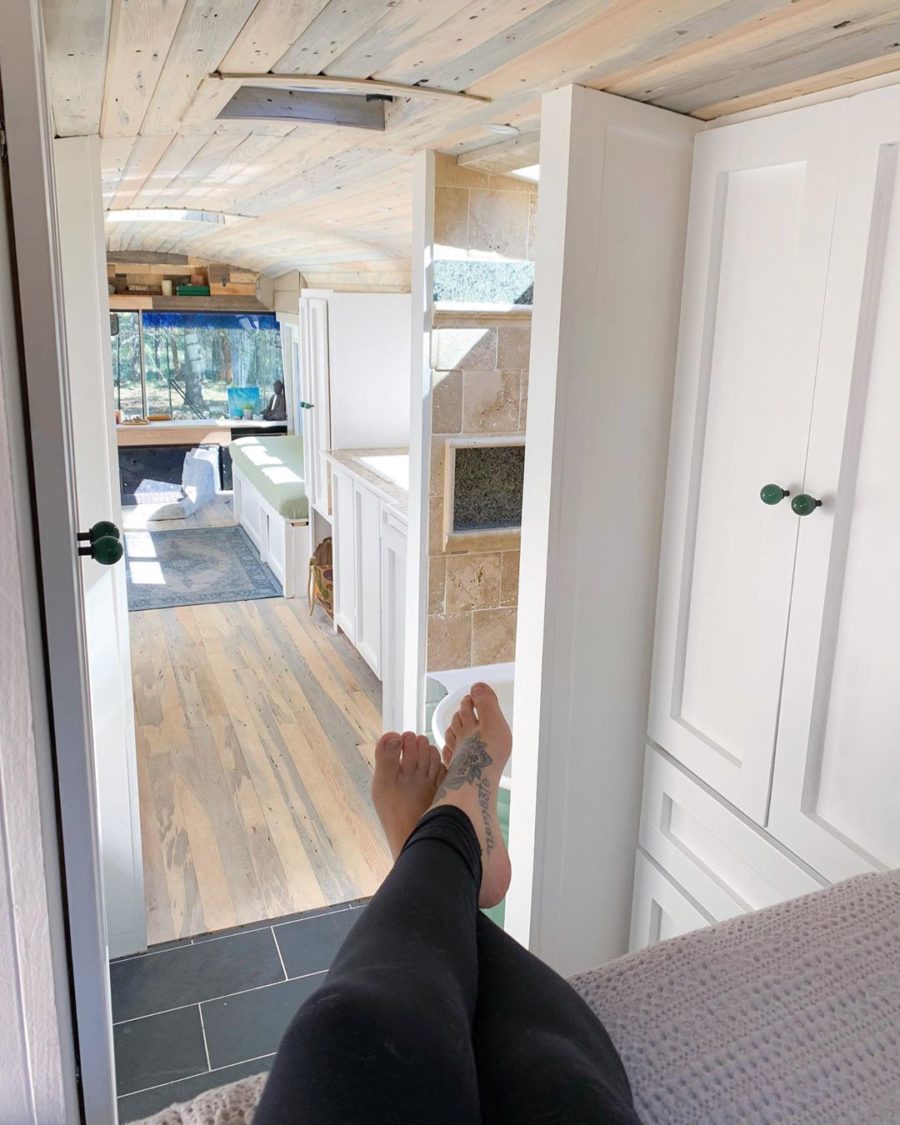
Images via @kacisage/Instagram
Kaci loves cooking from scratch!
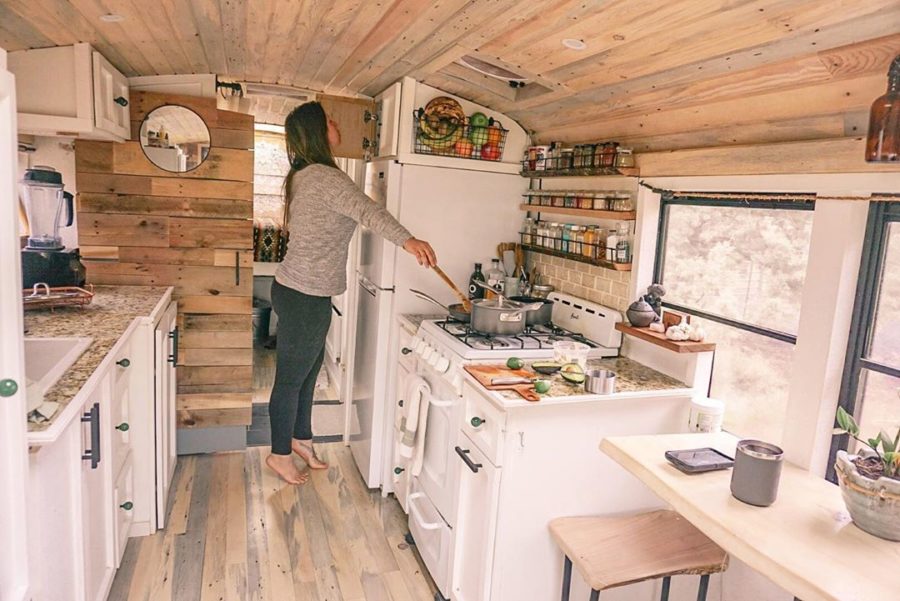
Images via @kacisage/Instagram
They have their desk/eating area next to the kitchen.
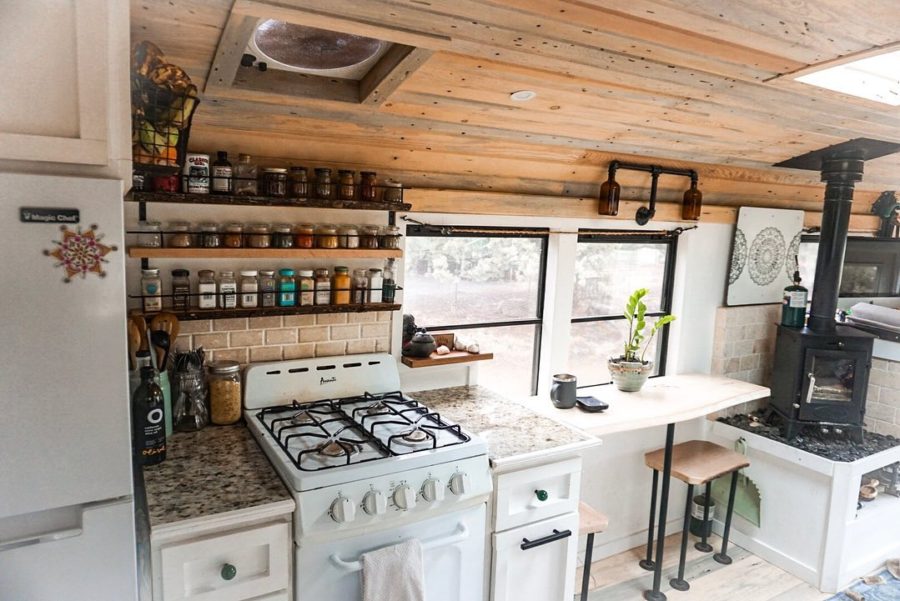
Images via @kacisage/Instagram
Anyone else jealous of this gorgeous spice rack!?

Images via @kacisage/Instagram
Good use of under-bed storage.
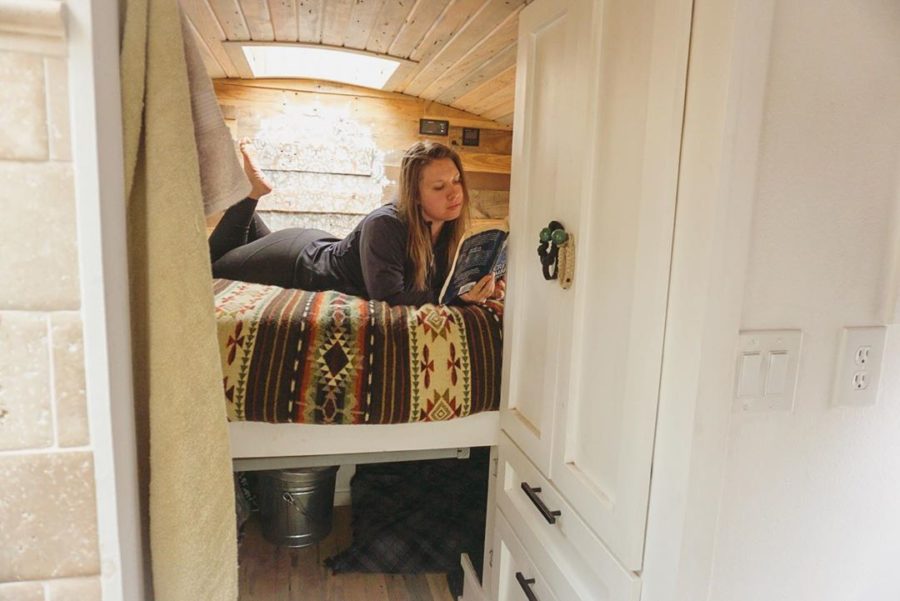
Images via @kacisage/Instagram
In-progress picture of the counter tops and backsplash going in.

Images via @kacisage/Instagram
I am obsessed with wood-burning stoves.
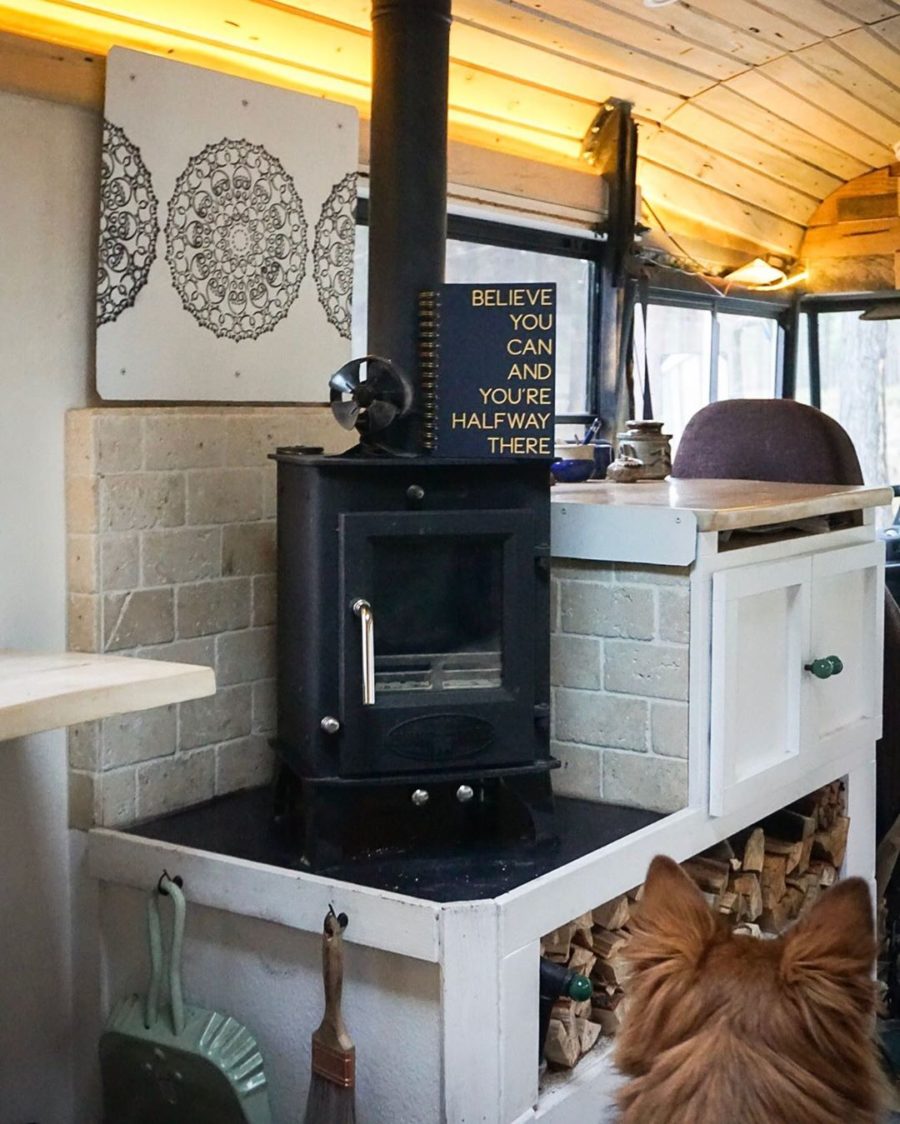
Images via @kacisage/Instagram
Love the little plants here.
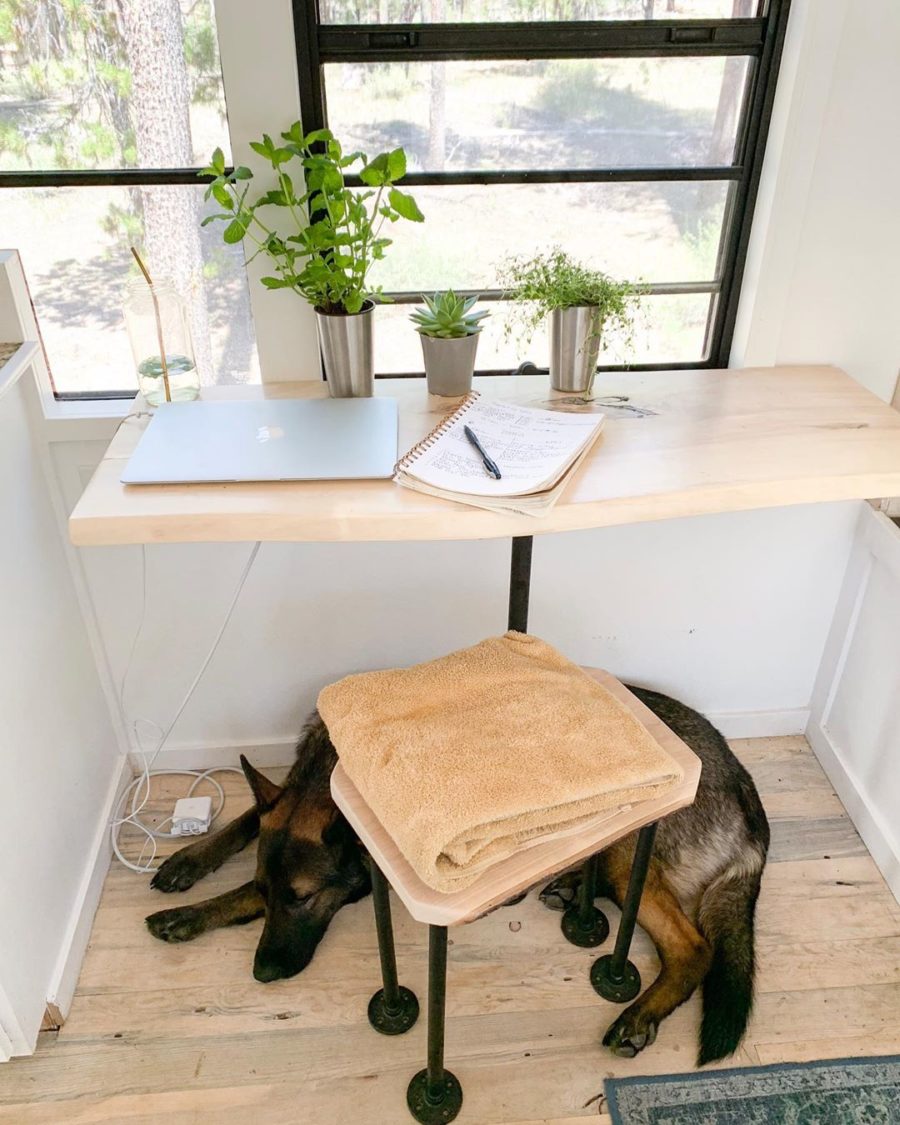
Images via @kacisage/Instagram
Time for some before & after shots!
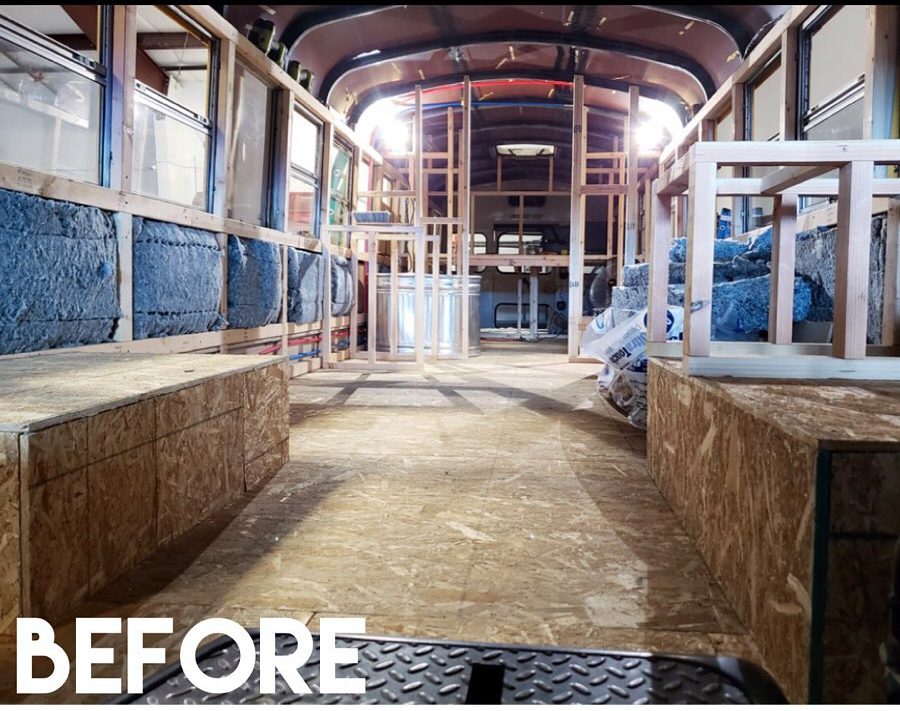
Images via @kacisage/Instagram
Breath-taking! Love the wood storage.
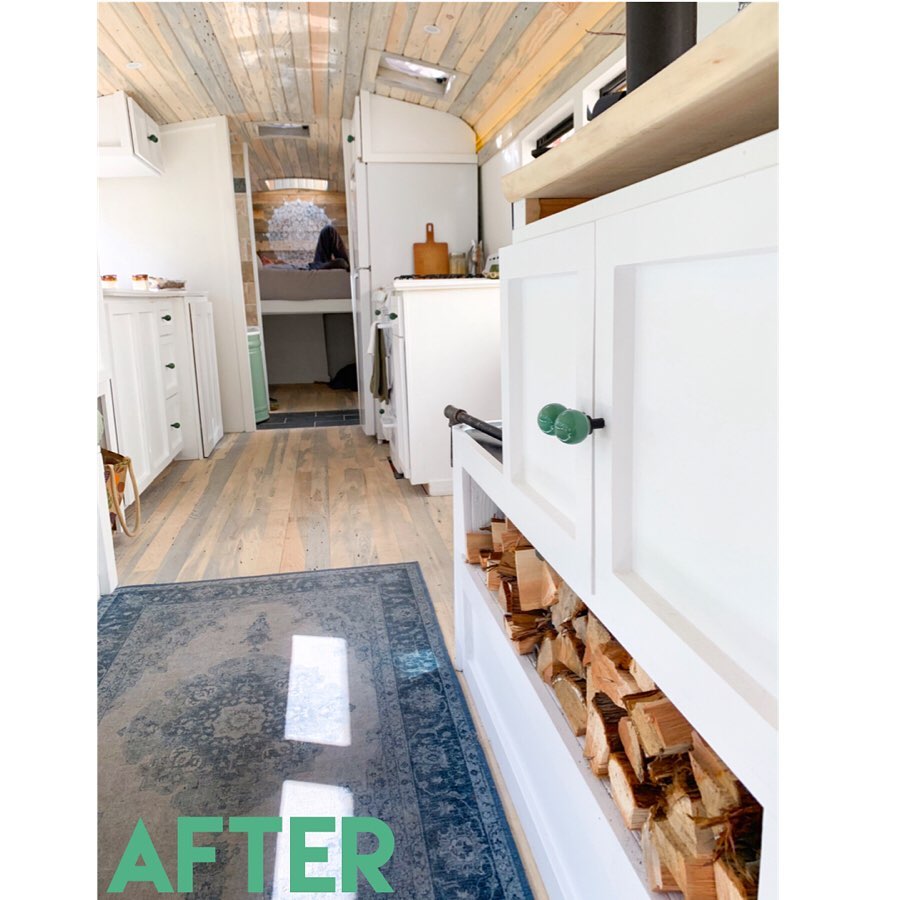
Images via @kacisage/Instagram
Love what they used for the tub.
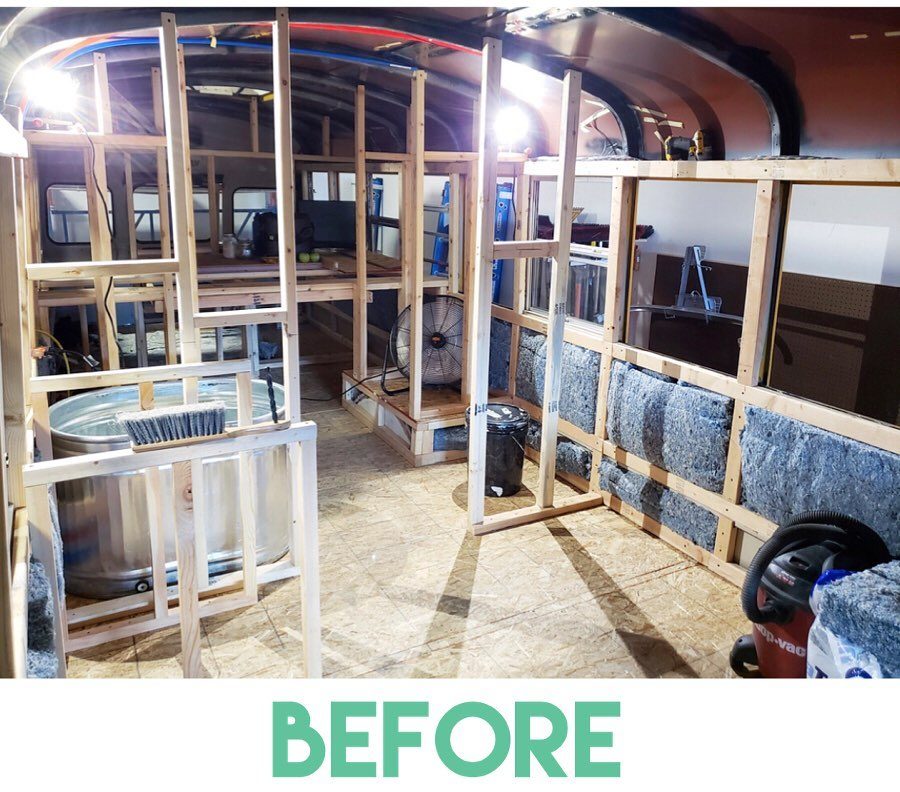
Images via @kacisage/Instagram
What a great transformation.
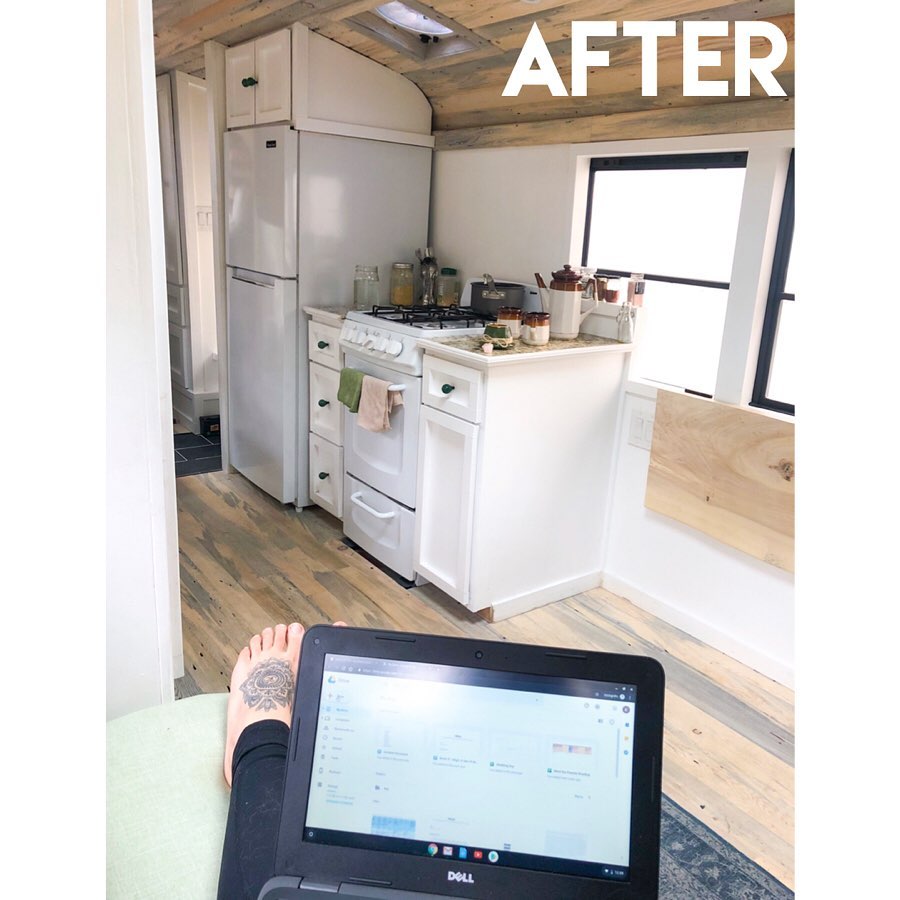
Images via @kacisage/Instagram
Shower time!

Images via @kacisage/Instagram
Wow how cool is this!?
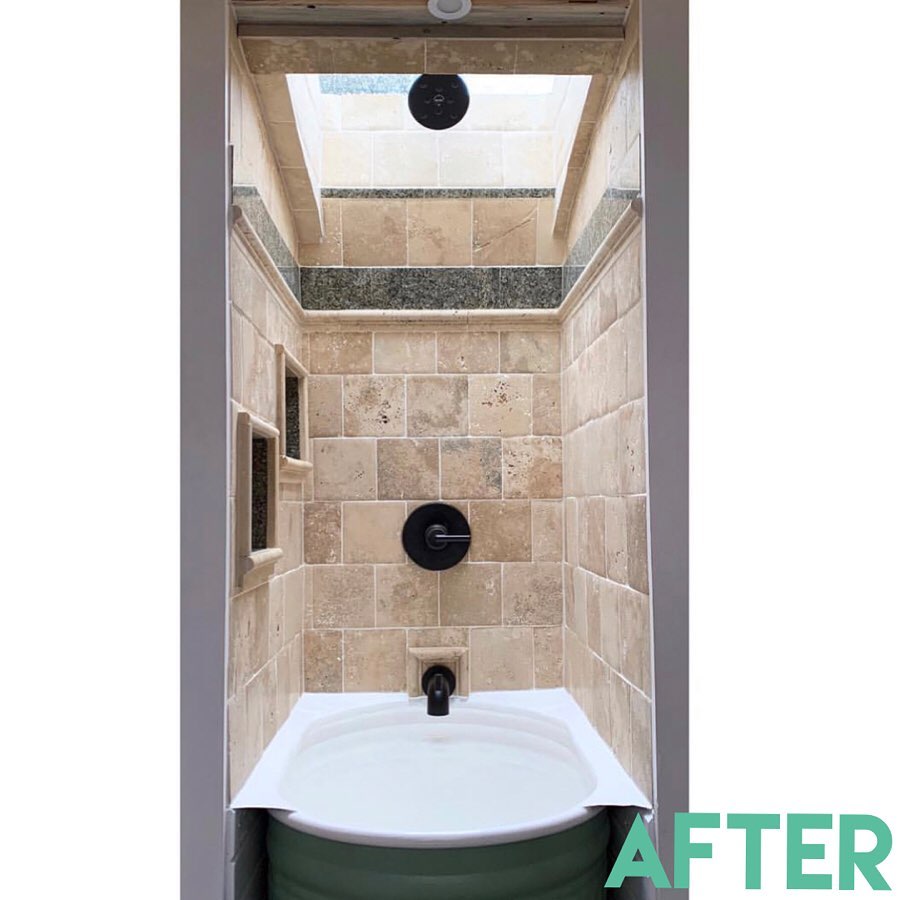
Images via @kacisage/Instagram
And they even have a guest bed!
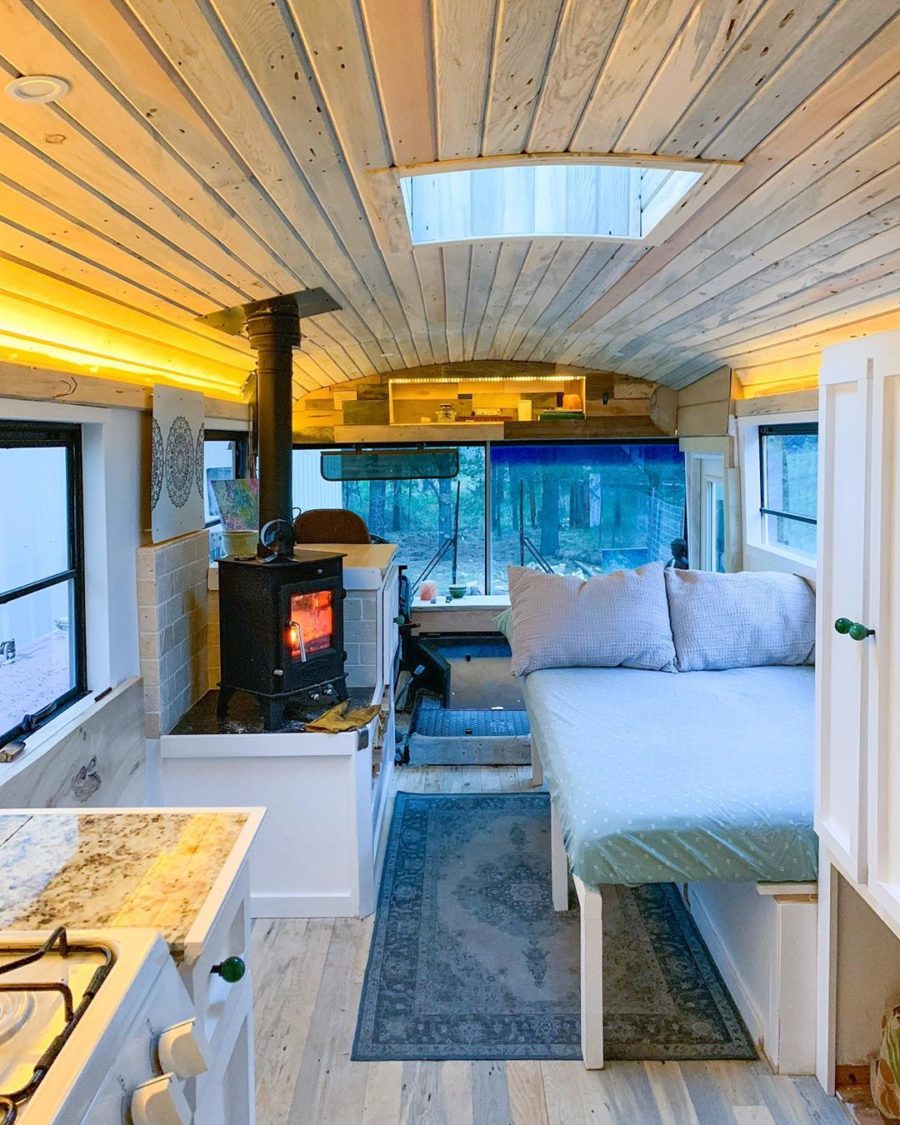
Images via @kacisage/Instagram
Very zen bathroom right here.
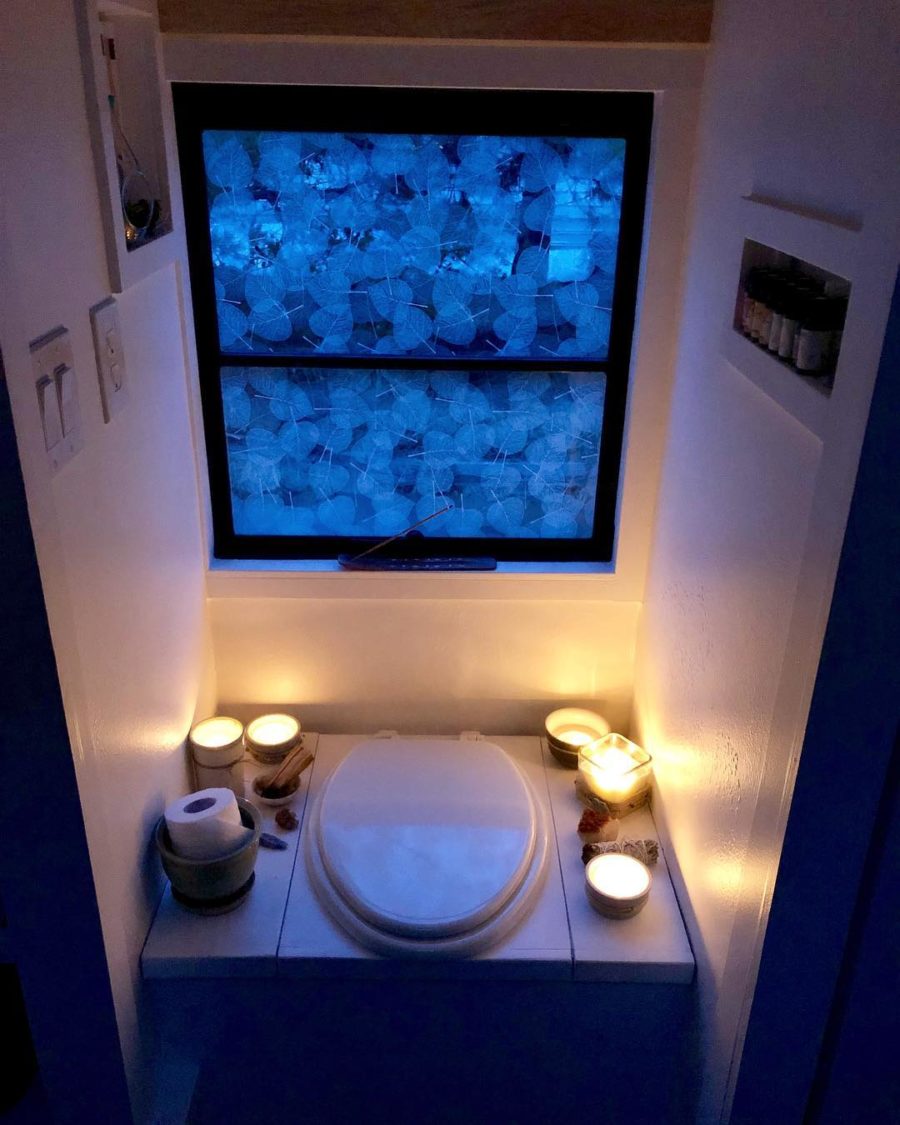
Images via @kacisage/Instagram
And here’s their amazing parking spot!

Images via @kacisage/Instagram
Growing their own food.
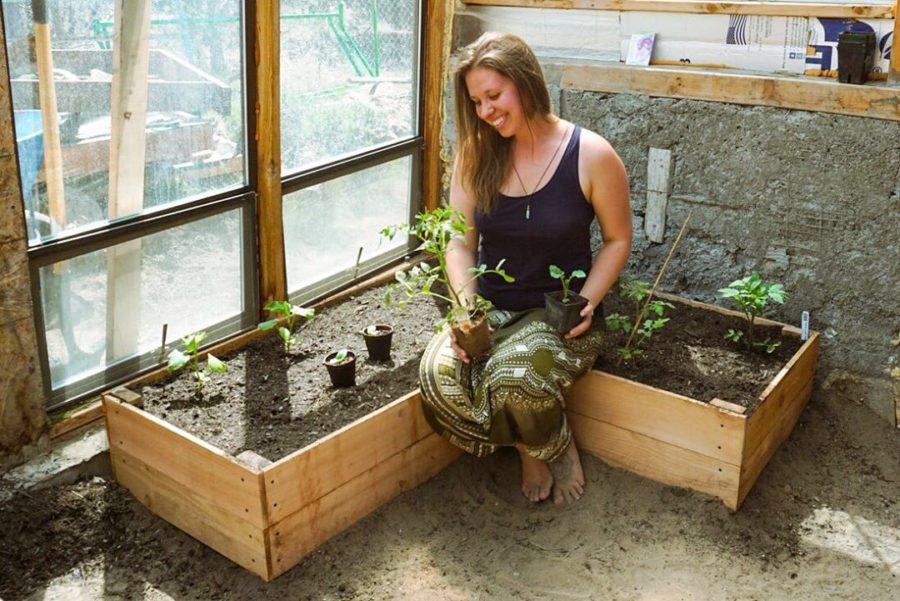
Images via @kacisage/Instagram
Interview with Kaci: Bus Life in Bend
What are your name(s)? We are Kaci + Eric, and our pups are Haines + Jasper
Where do you live? We live amongst the towering ponderosas, fragrant sagebrush, and majestic Cascade mountains of Central Oregon, specifically, Bend.
How long have you lived tiny? When we first moved to Bend in 2017, we found a 200 square foot creekside cabin in the woods that we rented for $800/month. Throughout the bus build, we ended up having to move out of the little cabin, we lived in an RV for a few months, then a tent, then (illegally, because we didn’t have a choice at the time) in the roofing shop where the bus was parked, then we stayed with a friend for a few months before moving into the bus. It’s been a journey, that’s for sure!
What do you do for work? Eric is a General Contractor with his own business, Central Oregon Roof & Remodel, and I’m a professional freelance copywriter that specializes in SEO blog posts, web, newsletter, and email copy in the holistic wellness, sustainability, and natural living niches.
Or do you travel full-time?
Our original plan WAS to travel full-time, but it hasn’t worked out that way, and we are totally okay with that! Our vision for our life has changed. The great thing about having the bus is that it’s given us the opportunity to slow down and really be intentional about our lives and what we want for our future.
Why did you decide to go tiny? We wanted to break free of the never-ending cycle of constantly having to work just to exist. We felt trapped by the lifestyle of paying so many bills every month… Rent, cars, insurance, utilities, cell phones, etc. etc. etc. The majority of our lives were spent working for other people’s companies making other people’s dreams come true, but not putting the time and energy into our own. We wanted the freedom to explore this beautiful planet, to not stress about money or owing anyone anything, and live life how we were truly meant to live: by just being.
What are you hoping to get out of living tiny? We wanted simplicity and freedom. A life focused on the little things and absent of hustle and bustle. We wanted to live life on our own terms. We still want that, and while we’ve achieved some of it, we have plans to dive even further into that goal with our next steps.
Why specifically did you choose a bus (instead of say an RV/van/tiny house on wheels)? As I mentioned, we originally wanted to travel full time. Our original plan was a Sprinter Van conversion, but they’re so freakin’ expensive. Plus, I really love to cook, and make everything from scratch most of the time, so the extra space of the bus was nice. We also thought it wasn’t exactly fair to a high-energy German Shepherd to keep him cooped in a van. School busses are also way sturdier than pre-fabricated RV’s that are usually made with unsustainable, low-quality materials and aren’t built to last.
How did you first learn about bus life? We’d been working toward van life for a while when we stumbled upon the Netflix documentary Expedition Happiness (which I have very different feelings about now that some time has passed). That sparked our Instagram exploration of #buslife and @buslifeadventure, and since we could afford a bus, we were sold.
How long did it take to finish your bus? Haha, anybody with a self-built tiny home knows it’s never really “done…” but all in all, with Eric working 50+ hours a week and building the bus out at night (I was pretty much immobile due to a back injury that later led to 2 surgeries) it took about 1.5 years.
How did you build your bus? Did you have any help? Did you do it yourselves? We did the build out 100% ourselves, yes. We started the demo phase at our little creekside cabin, then moved it into the roofing shop of the company Eric was working for at the time. The community here really came through for us on the build in that way. The only thing Eric didn’t do himself was weld our custom water-tank mounts, which a neighboring shop owner did in exchange for a case of beer.
Are you comfortable sharing how much your tiny home cost? We went into it with the mentality of “sustainability and quality,” so including the responsibly sourced beetle-kill pine, post-consumer recycled denim insulation, granite counters, travertine shower, skylights, and raptor liner exterior paint job, all-in-all we’re probably sitting around $35,000 for total cost including the bus price ($4500).
What are bills/utilites like compared to before? Well, we’re fortunate enough that the place we’re currently parked costs a whopping $0. We somehow stumbled across an 83-year old local man who’s let us park and live on his 2.5 acre parcel with a view of the mountains completely free. He doesn’t charge us for water or electricity, and he’s even let us use his greenhouse and outdoor garden space for the summer. We are immeasurably blessed. We understand this isn’t the norm. When we were living off-grid in the national forest before we parked here in October, we’d pay $2 max to fill our water tank each time (if anything at all) and our electricity is free because of our solar set up. Our heat is also free because we’ve got a wood stove. The only “utility” I guess you can say we pay is propane, which probably costs us about $15/month. We’ve minimized other bills as well with a true goal of living as simply as possible.
How did you find a place to park and live in your bus? We’re lucky that in Oregon, there’s an abundance of national forest that’s a boondocker’s paradise. Other than that though, we’ve continuously been blessed by our connections in the community and the generous hands of our neighbors who’ve welcomed us with open arms.
Before going tiny, what was life like? Man, we’ve come a long way and we owe a lot of it to this buslife journey. Eric was a wildland firefighter, and I was an Assistant General Manager in the seasonal hotel industry in national parks. We were both trading our days, sanity, and mental/physical/spiritual wellbeing for gold, and we were convinced it’s what we had to do, because that’s what we’re all taught. We each paid $1,000 in rent before utilities and other bills, and were dedicated on working our way up the ladder in an effort to gain success and stability. Then, we realized that kind of lifestyle never affords you either. We’ve never looked back.
Is there anything from your old life that you miss? Mmmm… Preparing things from scratch in a larger kitchen would be nice, and not having to go to the laundromat is a convenient luxury. But I don’t focus on those things, because they’re such small trade-offs for the quality of life and opportunity bus life has given us.
What benefits are you experiencing after going tiny? More time to be intentional with our actions, choices, and activities. We don’t have to work nearly as much, and actually have time to work toward our own passions and endeavors that provide a greater level of satisfaction and financial freedom than we ever had before. We have time to spend together, working on our personal growth and to appreciate the things that really matter in life. We’ve learned new skills, healed old trauma wounds, and strengthened our relationship in ways I didn’t think was even possible because we’ve had the time, energy, and lack of stress to focus on it. (That being said, the journey here was grueling, and we sacrificed every known comfort in a dedication to get where we are. It was NOT easy. But it is possible, and it is worth it.)
And, our house moves! So if anything ever changes, or we feel like the next adventure lies elsewhere, we’re not stuck on this little parcel of land we’re parked on.
What makes your bus special? Built with Pachamama in mind, we’ve chosen as sustainable materials as possible. The beetle-kill pine is a true work of art, and we were able to incorporate granite countertops and travertine shower tiles that we kept from going to a landfill, a real stone hearth, and a full little luxury kitchen. We incorporated a 50 square foot garage for gear storage and toys. We’ve got built-in his + hers closets, and also have a full “dog den” built for two dogs including a large bed space where they can stand, and custom shelves for their food and water bowls. There’s a lot of things that make our bus special, honestly. But. what’s really cool about buslife is that everybody’s bus is special to them, built for their unique needs and their unique lifestyle. When you live tiny, each and every little detail is an opportunity to be intentional, and so every small home is special in its own way.
Is there anything you’d change about your bus now that you’ve been living it? Haha, SO MANY THINGS! No, just a few really. But, yes, there are definitely things we’d change. Where we mounted the water tanks, leaving the original windows in, our style of shower, and a some building materials are a few. We’ll likely change a few of these things in the near future, though. Like anything in life, nothing is ever “set in stone.” I plan to write a blog article/make a YouTube video of our buslife regrets in the near future, which will end up on kacisage.com
Do you plan on living this tiny forever? If not, do you think this experience will make you live differently in the future? We don’t plan on living tiny forever, but we do plan on living intentionally forever. Our next steps offer us a bit more space, but incorporate nature even more into our daily lives. We’ll always be intentional with our true needs, and the things that really bring value to our lives. The feeling of being “free” from all your “junk” is really liberating. Materials things will never be our focus, but for our future goals, a little more space will be needed. 😉
What helpful advice would you give to others interested in going tiny?
You are infinitely capable to create any life you can possibly imagine or desire. Believe you can, and you’re halfway there. Don’t get discouraged and quit halfway through. It won’t be easy, but it will be worth it.
Bus Highlights:
- Wood-burning stove
- Custom spice-rack
- Large oven/stove for cooking
- Large fridge/freezer
- Fold-out guest bed
- Cost $35,000 to renovate (including cost of bus)
- Living for FREE on older man’s land
- Composting toilet
- Travertine-tiled shower
- Beetle-kill pine
- Post-consumer denim insulation
- Recycled granite counter tops
- Took 1.5 years to build out (while doing 50 hours/week at day job)
Learn More:
You can share this using the e-mail and social media re-share buttons below. Thanks!
If you enjoyed this you’ll LOVE our Free Daily Tiny House Newsletter with even more!
You can also join our Small House Newsletter!
Also, try our Tiny Houses For Sale Newsletter! Thank you!
More Like This: Tiny Houses | Bus Conversions | Australian Family Sells “Dream Home” to Live & Travel in a Bus! | Cedar Bend Travels: Family of 6’s Bus Life | One Wild Ride with Lexi & Tyler: From Traveling to Homesteading in their Bus Conversion
See The Latest: Go Back Home to See Our Latest Tiny Houses
This post contains affiliate links.
Natalie C. McKee
Latest posts by Natalie C. McKee (see all)
- N2 in Palm Court at Escape Tampa Bay: $40k Discount! - April 23, 2024
- Traveling in their Vintage Bus Conversion - April 23, 2024
- 20 ft. Modern Farmhouse on Wheels - April 23, 2024




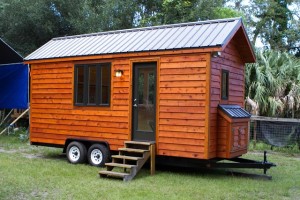
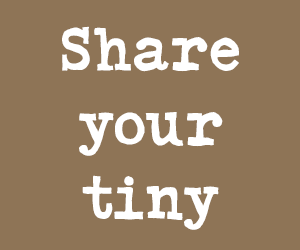
I love buses more than anything, and yours is really beautiful and welcoming inside. Lovely decorations and great design ideas. Love the wood ceilings and the wood on the bedroom walls. It’s a wonderful home!
Oh. . .and that shower is amazing!!!